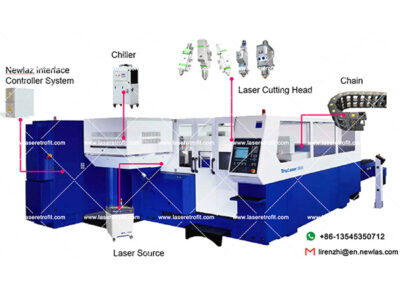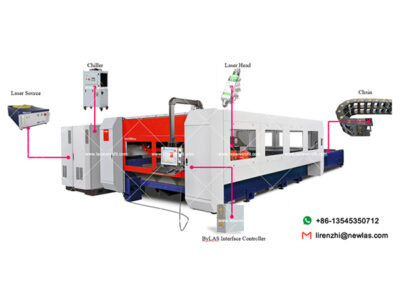Everyone is talking about fiber lasers, as the lure of no maintenance for the laser head is definitely appealing to companies with older CO2 machines that might require routine service to keep them cutting.
But if you’re looking for increased laser performance, can it be right decision for you?
Buying a new fiber laser might be a bit rich for some companies. So the next question is, can a fiber laser be retrofitted to an existing laser system’s frame? The short answer is yes, but the entire answer requires more information.
Before the decision is made to retrofit a CO2 laser with the latest and greatest products, you need to get past all the hype of having the newest laser. Remove all of your emotions and consider all of the facts before you invest your money. You need to ask yourself some questions before you can ask laser manufactures questions about retrofitting.
The first thing you need to understand is that the fiber laser emits a different wavelength of light than your CO2 laser produces. The fiber laser emits an approximately one-micron wavelength while a CO2 laser emits one at approximately 10 microns. This one-micron light wavelength is capable of going straight through to your eye’s retina, causing irreparable damage.
So it needs different safety systems along with a complete enclosure around the cutting area, which is different than a CO2 laser’s requirements. When you inspect new fiber laser centers, you’ll notice many manufactures have added cameras pointed at the cutting process. These cameras allow the operator to see or interact with the cutting process while safely staying out of the enclosed area.
This wavelength of light makes it possible for the light to travel through fiber and doesn’t need the external optics in the beam delivery system that a CO2 laser requires.
Furthermore, the shorter wavelength couples or absorbs into material differently than a CO2 laser beam does. The CO2 beam absorbs consistently over the angle of incidence (AOI). AOI is the angle from where the top of the beam enters the material to where it exits from the bottom of the material when you factor in the cutting feed rate. As the material gets thicker, the CO2 beam gives a more repeatable cut result.
As the material gets thicker, the fiber-laser beam requires correcting to compensate for the shorter wavelength and how it absorbs into the material. This absorption results in high cut speeds in thin material compared to a CO2 laser, but the results start to favor the CO2 laser when materials get thicker. So when you calculate your ROI, you need to consider what material you plan on processing.
When deciding to retrofit your machine with a new laser head, which is a major investment, careful consideration is needed to make sure you are getting the full potential of your investment.
First I would list everything that is wrong with your current system and then put a price on those items to correct them.
The next step is to evaluate your current machine and ask yourself the following questions:
1. What are the problems of my current configuration?
2. Will a retrofit correct all of these problems? Remember, it’s just the laser beam that’s new, not the entire machine. So, if you had a bad ballscrew before the upgrade, you will still have a bad ballscrew. If you keep your current machine and add the price of the retrofit, plus the downtime to perform it and the time to work out any configuration issues, would the total price add up to more than what your machine is worth? Or could you use that money toward purchasing a new machine with a two-year warranty that will cover the entire machine and not just the new retrofitted parts?
3. What do you expect from a retrofit? Are you looking for faster cycle times, the ability to process thicker materials or a reduction in hourly runtime costs?
4. Will your machine be capable of using all of the features of the retrofit? Some older controls might have limits on how much power they can produce or the frequency it pulses at might have limitations.
5. Will your current drive system produce the extra speed when cutting thin material while still delivering the same accuracy?
6. Will the manufacture still support your machine after you retrofit it if you use a third-party laser head?
7. Who is capable of servicing the new laser along with the old machine?
8. Who wants to talk about the white elephant in the corner?
Because personally, I’ve seen hundreds of retrofits over the years and some were integrated with a true advantage for the customer and benefitted the machine resale value. On the other hand, I have seen more retrofits that were a true challenge to operate. An example would be alarm messages that were so generic that it was impossible to tell exactly what went wrong and why the machine stopped. They really became a challenge to repair. Or machines that had high-power lasers installed with no way to take advantage of the power, because the cutting head was unable to change to the focus required, or the lens with the proper focal point for heavier material couldn’t be changed out. Some ideas are better on paper than in practice.
Remember, you will have a large investment in an older machine, and if it were to run great for years, at what point do you get a payback for the money you invested? You can calculate the known factors from increases in production, but in reality, only the types of parts that you cut plus the reliability of the older portion of the machine will decide your return on investment.
If you decide to sell your machine in the future, is there a market for it? Look at it this way, if you have an older car, let’s say a Model T, and you put a custom built motor in it capable of 200 MPH, will you be able to find someone willing to pay for this configuration?
Finally, the vendors you choose to purchase a product from truly become business partners with you, whether you like it or not. Some are there to see you succeed and others are there to sell parts. You must decide which type of vendor you want to be partners with.
Cr: Todd Jacobson, Laser Maintenance Group Corp.






